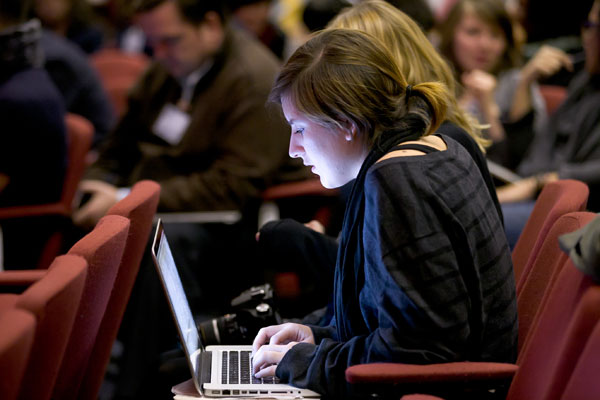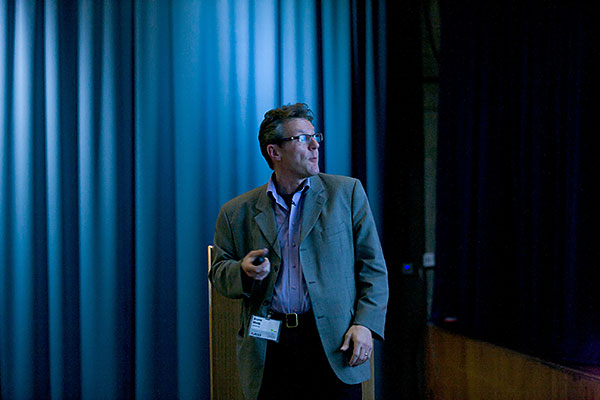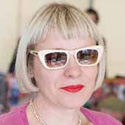
Morag Myerscough was part of an eclcectic mix of English as well as international speakers at the first TYPO London conference in October 2011 (©kassnerfoto.de)
Creative Review:
Design Indaba: Places of Type by Lynda Relph-Knight
Epic Flickr photo album by Michael B. Johnson: TYPO London 2011 Trip
Salford University Blog: The TYPO London conference
Eye blog: In the bunker
Design Assembly:
- Typo London 2011 – Jonathan Ellery
- Typo London 2011 – Dale Herigstad
- Typo London 2011 – Gary Hustwit
- Typo London 2011 – Andrew Stevens
- Typo London 2011 – Neville Brody
- Typo London 2011 – Marina Willer
- Typo London 2011 – King Bansah
- Typo London 2011 – Chip Kidd

TYPO London attendees photographed, twittered and blogged conference content worth spreading (Photo: Gerhard Kassner)
The FontFeed:
- Looking Back On TYPO London 2011 “Places”
- A (Bald) Condensed View on Day One of TYPO London “Places”
- A (Bald) Condensed View on Day Two of TYPO London “Places”
FontShop USA: Reflections on TYPO London
The Wanderlust: Typo London Places 2011 review and summary
Eva-Lotta Lamm: TYPO London 2011 Sketchnotes
Sense Worldwide: Tim Fendley at Typo 2011 – Legible London
Computer Arts:
Slanted:

TYPO London speaker Karin von Ompteda (Photo: Gerhard Kassner)
stylus.com:
- Ones to watch
- Takeaways & Quotes
Kira Slepchenkova: Post Time
Megaluna: Ik heb 18 fotos op Facebook geplaatst in het album Typo 2011
Design Week:
Birdwatching: TYPO London 2011
Hannah Gibson: TYPO London
Sol Kawage: London
That Design:
- Marina Willer – Branding and Spaces
- Jeff Faulkner – Extraordinary Machines
- Morag Myerscough – Belonging
- Dan Rhatigan – How I learned to Stop Worrying and Love Bad Type
- Toshi Omagari – Creating Linotype Didot
- Nadine Chahine – Engaging with the Middle East
- Bruno Maag – Collaborating Types
- Julian Zimmermann and King Bansah – The King is Customer
- Jonathan Barnbrook – Virus
- Chip Kidd – What Are You Doing Here?
Theo Inglis: TYPO London 2011 – Michael Bierut

TYPO London speaker Bruno Maag (Photo: Gerhard Kassner)
W210 blog: Typo London 2011
Sydney Soan: The first ever TYPO London …
Ben Mitchell: Typo London
Sydney Botting: TYPO London 2011
König Bansah: Königliche Autogrammstunde auf der TYPO London 2011
Construct: Drawing competition at TYPO London Speakers Dinner

TYPO London speaker Jonathan Barnbrook (Photo: Gerhard Kassner)
TYPO London Blog:
- Dale Herigstad: When the rectangle is gone
- Nat Hunter – Telling the Right Story
- Kutlu Çanlioglu and Titus Nemeth: The raster tragedy
- Michael Bierut: A Journey to Ten Locations and Ten Projects
- A (Bald) Condensed View on Day One of TYPO London “Places”
- Tony Brook: Stalking Your Idol – 5 Handy Hints
- Jonathan Ellery: The Here and Now
- Dale Herigstad: Media Space – Where is what? What is where?
- Gary Hustwitt: We built this City
- Antony Harrington: London Typographica
- Michael B. Johnson: Pain Is Temporary, Suck Is Forever
- Andrew Stevens: Collaboration and Tactility
- The Creative Lexicon
- Gary Hustwit: Urbanized
- Lawrence Weiner: An Artist To The Core
- Dylan Griffith: Scale and Reach…
- Tom Uglow: The Art of Post Digital
- Neville Brody: Education and Experimentation
- Morag Myerscough: Belonging
- Jeff Faulkner: User Experience and The Point of Singularity
- Marina Willer: Branding Spaces
- Tim Fendley: Legible London in 10 Headlines
- Susana Rodríguez de Tembleque: The Art of Creating an Experience
- Bruno Maag: Collaborating Types
- Ivo Gabrowitsch: App Fonts – The New Web Fonts
- Chip Kidd
- The King Is Customer
- An Hour of Impeccable Comic Timing, Pauses and Eyebrow Raises
- A (Bald) Condensed View on Day Two of TYPO London


































Pingback: This Week in InDesign Articles, Number 77 | InDesignSecrets